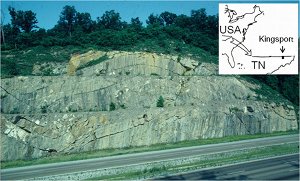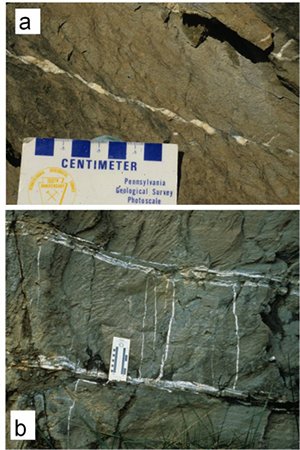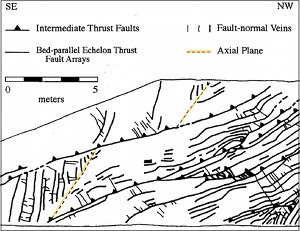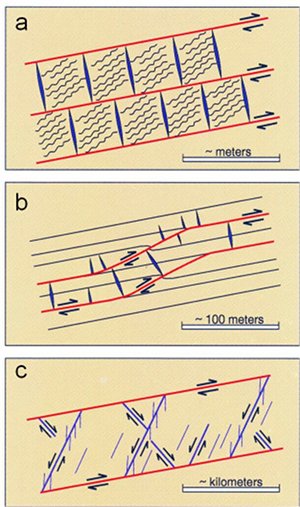|
Excellent outcrops exposed along highway cuts at northeastern Tennessee (Figure 1) provides opportunities to decipher folding and faulting of rocks, particularly bedding plane slip-based thrust fault systems and the associated structures (Diegel and Wojtal, 1985; and Ohlmacher and Aydin, 1995; 1997) in the Appalachian fold and thrust belt. Along I-181 at Bays Mountain near Kingsport, hundreds of meters long highway cuts with several tens of meters height expose the Ordovician Sevier Shale which consists of thinly-bedded, alternating gray shale, siltstone, and minor amount of sandstone with carbonate cement.
 | | Figure 1. Face of a highway (US 19E) cut showing folded, fractured and faulted carbonaceous shale (Ordovician Sevier Shale) across Bays Mountain, near Kingsport, Tennessee. From Ohlmacher and Aydin (1995). |
The images in Figure 2a and b show that bedding plane-slip and the resulting veins and pressure solution seams, which are pervasive throughout the outcrop, were important deformation mechanisms. Figure 3 is a map of a portion of the highway cut showing a series of intermediate size thrust faults offsetting the axial plane of folded strata for several meters. At this scale, it is still possible to identify veins parallel and perpendicular to bedding and bed-parallel faults inherited from an earlier deformation phase and some secondary structures oblique to the intermediate thrust faults. In other locations, slabs of rocks bounded by thrust faults are deformed by veins and in some cases, by normal faults.
 | | Figure 2. (a) Bed-parallel slip associated with incipient thrust faults and the related rhomb-shaped pull-apart veins and pressure solution seams (dark lines diagonal to the fault trace) at Bays Mountain, Tennessee. (b) A photograph showing two small bed-parallel thrust fault zones marked by elongated calcite veins and a series of orthogonal veins and diagonal pressure solution seams. Note that the veins in this case are perpendicular to the bedding plane faults. From Ohlmacher and Aydin (1995). |
 | | Figure 3. A map of a portion of the highway cuts at Bays Mountain showing a series of intermediate size thrust faults with several meters offset and the associated veins. From Ohlmacher and Aydin (1995). |
A series of idealized diagrams in Figure 4a, b, and c illustrates these hierarchical cases.
 | | Figure 4. Schematic illustration of the growth of the thrust fault in the Sevier Shale during the Alleghanian Orogeny affecting the Appalachian Mountains. (a) bed-parallel thrust fault arrays with bedding normal veins. Wavy lines between the veins represent bed-oblique splay pressure solution seams. (b) faults develop across multiple layers, connected by the splay pressure solution seams. Fault-normal veins connect the intermediate thrust faults. (c) Normal faults with apparent conjugate pattern develop between the thrust fault array. From Ohlmacher and Aydin (1995). |
| |
Diegel, F.A., Wojtal, S.F., 1985. Structural Transect in SW Virginia and NE Tennessee: In Woodward, N.B. (Editor), Field Trips in the Southern Appalachians: University of Tennessee, Department of Geological Sciences Studies. Geology 9: 70-143.
Ohlmacher, G., Aydin, A., 1995. Progressive deformation and fracture patterns during foreland thrusting in the Southern Appalachians. American Journal of Science 295 (8): 943-987.
Ohlmacher, G., Aydin, A., 1997. Mechanics of vein, fault and solution surface formation in the Appalachian Valley and Ridge, northeastern Tennesssee, U.S.A: implications for fault friction state of stress and fluid pressure. Journal of Structural Geology 19: 927-944.
|



